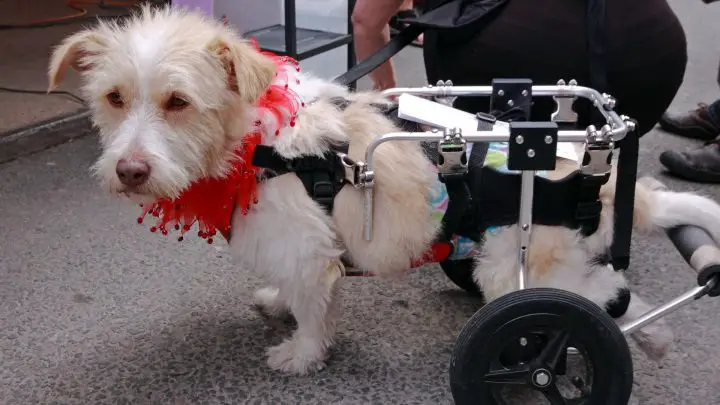Just like humans, dogs will limp if one or more of their legs is hurting, in order to relieve the pain. If you notice that your dog is limping, it’s likely they’re going to need veterinary attention. But that doesn’t mean it’s always something serious. There are a number of things that can cause a dog to limp.
So, what can cause a dog to limp, and when should you get in touch with the vet? The following will answer both of these questions, as well as tell you everything else you need to know about limps in dogs.

Inhaltsverzeichnis
- Gradual Onset Limping vs Sudden Limping
- What Can Cause A Limp In Dogs?
- Which Dog Breeds Are At The Highest Risk Of Leg Injuries?
- When Should I Contact The Vet About My Dog Limping?
- How To Treat A Dog Limp
- Conclusion: Why is My Dog Limping?
- Häufig gestellte Fragen
Gradual Onset Limping vs Sudden Limping
The two types of limps are gradual onset limps, und sudden limps.
Gradual onset refers to when the limp happens gradually over time, to the point where the owner might not even notice anything at first.
These limps may be caused by underlying conditions, like dysplasia or osteoarthritis.
A sudden limp would be one that occurs quickly, and this kind of limp is more likely to have been caused by an injury or similar trauma.
It’s important to keep an eye on your dog’s regular movements, so you’ll be able to tell immediately if there’s a sudden limp.
Knowing whether the limp is a gradual onset limp or a sudden limp will help your vet work out what’s going on.
What Can Cause A Limp In Dogs?
When it comes to the queries that vets receive, limping is one of the most frequent. There are many potential reasons your dog could be limping.
Here are all of the most common ones:
Joint Disease
Joints can experience gradual wear and tear due to certain conditions, which leads to your dog getting a limp.
Some of these conditions include Hüftdysplasie, osteoarthritis, patellar luxation, elbow dysplasia, intervertebral disk disease, ligament disease, and osteochondritis dissecans (OCD).
If your dog is experiencing any of these conditions, the affected limb or limbs are likely to hurt, causing them to limp. Infections like
Lyme disease can also cause joint pain, which is why tick preventatives are so important.
If your vet confirms that your dog is suffering from arthritis or dysplasia, they’ll usually recommend a joint supplement consisting of chondroitin and glucosamine. This should help to reduce the dog’s symptoms.
Injury To The Paw
If your dog has stepped on something sharp, or has got that something stuck in their paw, this would make it very uncomfortable for them to walk normally, thus explaining the limp.
It can also lead to infection, so always check your dog’s paws if you notice them limping, or licking their paws more than usual. It may also be possible your dog’s paw is suddenly pink.
Other paw injuries could include insect stings, animal bites, broken toenails, lacerations, frostbite, burns, and bruises.
More Serious Injuries Or Trauma
In these cases, it would likely be obvious to the owner what’s been causing their dog’s limp.
Just like humans, dogs can suffer from bone fractures, dislocations, sprains, spinal injuries, ligament tears, and joint trauma. All of these can lead to either moderate or severe limps.
Oftentimes when your dog is a puppy they’ll limp for no apparent reason- sometimes when they’re fully grown, too.
If your puppy seems to have a slight limp, wait around 15 minutes and then try to keep them still and quiet.
If after this time they’re back to normal, then you’ll have nothing to worry about, but if they continue limping then you should contact a vet.
Bone Disease
Younger dogs, particularly large breed puppies, are most susceptible to conditions that affect the bones, like panosteitis und hypertrophic osteodystrophy.
Some cancers can also affect a dog’s bones, like osteosarcoma. These conditions can make walking very painful for dogs.

Which Dog Breeds Are At The Highest Risk Of Leg Injuries?
Some breeds of dog are at more risk of leg injury (and therefore limping) than others, which is usually due to anterior cruciate ligament (ACL) tears.
The breeds of dog most at risk are Newfoundland, Bichon, Bernard, Rottweiler, German Shepherd, und Labrador Retriever.
When Should I Contact The Vet About My Dog Limping?
You should consult with a vet as soon as possible if your dog has started limping suddenly.
As we’ve said, there are a number of reasons your dog could be limping and not all of them are serious, but you should still seek veterinary attention for your dog.
If you notice a sudden limp and your regular vet isn’t available, seek emergency veterinary care elsewhere.
If you start to notice a gradual onset limp that doesn’t appear to be going away after a day or so (or appears to be getting worse), it can’t hurt to contact a vet. While you can give your dog something for pain (such as Hüftschmerzen), contacting your vet could be getting ahead of a serious condition like joint disease, or a spinal injury.
The sooner you schedule an appointment, the better.
How To Treat A Dog Limp
If you’ve arranged for a veterinary appointment and are now waiting, try to keep your dog calm and rested. Playing or exercising could exacerbate the limp, so make sure their movements are minimal.
Crate your dog if you need to. In some cases, continued rest could be all the dog needs to be relieved of the limp.
Conclusion: Why is My Dog Limping?
There are a number of reasons your dog could be limping: paw injuries, joint disease, bone disease, injuries or trauma.
If you notice your dog is limping, whether it’s occurred gradually or suddenly, make sure to give them plenty of rest.
If the limp has appeared suddenly, you should contact a vet immediately, and if a limp has appeared gradually but doesn’t appear to be going away after over a day, you should also be scheduling an appointment with your vet.
With any symptom like this, the sooner you seek veterinary attention the better.
Häufig gestellte Fragen
In many cases, limping might be caused by a minor injury or strain that will resolve on its own with a bit of rest. However, if you’re unsure or concerned about your dog’s limp, it’s always better to err on the side of caution and consult with a veterinarian.
Yes, in many cases, a dog’s limp can heal on its own, especially if it’s caused by a minor injury or strain.




